The tennis world continues to marvel at how Rafael Nadal won an unprecedented 12th Roland-Garros title.
Here are the key areas in which the Spaniard took charge to rule Roland-Garros once again.
Please upgrade to the latest version for best user experience.
You can also try using other popular browsers.
Update my browser
Spaniard clinches a 12th Roland-Garros title by beating Thiem in four sets on Sunday.
 ©Nicolas Gouhier / FFT
©Nicolas Gouhier / FFTThe tennis world continues to marvel at how Rafael Nadal won an unprecedented 12th Roland-Garros title.
Here are the key areas in which the Spaniard took charge to rule Roland-Garros once again.
For Dominic Thiem it was an explosive start. Having never taken a set off Nadal in three previous Roland-Garros encounters (2014, 2017, 2018), the Austrian was well aware he needed to burst out the blocks.
A sublime net duel at 2-2 and a brace of rattling inside-out forehand winners punched the first break on the board for Thiem.
Here to play.
— Roland-Garros (@rolandgarros) June 9, 2019
Here to win?#RG19 pic.twitter.com/RpILiyWNqs
However, Nadal lassoed a trademark forehand cross court to ignite his final, and immediately broke back.
The rallies continued to be brutal, lung-bursting exchanges, with Thiem having to put in so much effort just for a single point. From 2-3 down Rafa collected the critical points to claim four successive games and the crucial first set.
The King of Clay is the master at dealing with adversity on the terre battue.
How about this for symmetry.
In their previous Roland-Garros meetings, Thiem failed to inflict major damage on the Nadal delivery. The Spaniard won a combined 73 per cent of points following first serves. On the other side of the net, Thiem had failed to dictate proceedings, winning just 58 percentage on those points.
This is a modal window.
In their 2019 instalment, the Austrian was landing his serve into the corners to pin Nadal back en route to snatching away the second set, but that was insufficient overall; he finished with the same 58% ratio of first serve points won.
Nadal, you guessed it, succeeded in 73% of points.
The image that springs to mind with Nadal on clay is the 33-year-old hauling himself across the baseline, sliding, scooping and sending scorching shots past perplexed opponents. However, he has also developed his net play.
On several occasions, in tight moments, the world No.2 attacked the net, not enabling Thiem to prolong the rallies. He even sprinkled in a few serve and volley points.
YOU CANNOT DO THAT, @RafaelNadal 🤯
— ATP Tour (@ATP_Tour) June 9, 2019
That is insanely good from the 11-time champ 😅
🎥: @Eurosport_UK | #RG19 pic.twitter.com/8QSIiM4Kja
So much so that Nadal finished the final with a 23-from-27 success rate at net with plenty of acute volleys destined for the highlights reel.
The champion finishes his fortnight with 90/125 success rate canvassing the net, applying plenty of pressure to his opponents.
The captivated Court Philippe-Chatrier practically gave Thiem a standing ovation after the exhilarating second set.
It seemed his piercing groundstrokes were dissolving the Rafa resolve.
But not quite. A change of bandana, a fresh set of clothes and Nadal wrestled back the initiative, in devastating fashion.
A sumptuous pick-up volley and curling forehand pass helped the defending champion claim 16 of the first 17 points of the third set to disintegrate Thiem’s momentum. From there, the 25-year-old Austrian never posed the same threat.
Stepping onto Court Philippe-Chatrier, Nadal had won every single best-of-five-set clay-court match in his illustrious career after claiming the first set.
So, down 6-3, Thiem faced a formidable task. And, after three hours of duelling, Rafa's record moved to 105-0, and counting...
Due to the challenging weather conditions, Thiem was on court for four consecutive days. The world No.4 navigated past Karen Khachanov in straight sets on Thursday, before a turbulent and fascinating five-set encounter with top seed Novak Djokovic.
It appeared the second set drained the resources of the Austrian; Nadal managed to nullify Thiem's artillery with his relentless retrieval skills and clay-court prowess.